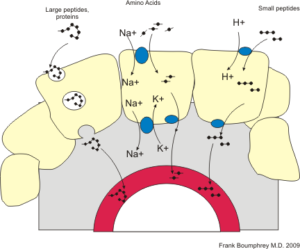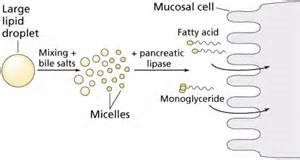Organisms exchange substances with their environment (AQA AS Biology) PART 3 of 5 TOPICS
TOPICS: Surface area to volume ratio Gas exchange Digestion and absorption Mass transport in animals Mass transport in plants
Digestion and absorption:
Large molecules are hydrolysed into smaller molecules so that they can be absorbed across the cell membrane.
The following molecules being digested and the absorption of the products must be known:
- Carbohydrates: Amylase in the saliva hydrolyses starch into two maltose molecules. Pancreatic juices that are secreted into the stomach contain amylase too. Maltase is embedded in the intestinal wall which hydrolyses the maltose into two glucose molecules. This is then absorbed into the blood stream by co-transport which is explained in ‘Biological molecules AQA AS Biology PART 8 of 8 TOPICS: Inorganic ions’. NB: It is important that you say hydrolyses and not break down as you will not get the mark.
- Lipids: Bile emulsifies fats in the stomach for digestion to happen faster. It is secreted by the liver. Pancreatic lipase hydrolyses the fats into monoglycerides and fatty acids. Monoglycerides and fatty acids combine with bile salts and phospholipids to form micelles. The bile slats and phospholipids allows the poorly soluble monoglycerides and fatty acids to the cells lining the intestinal walls where the non-polar nature of these molecules help them to diffuse through the lipid bi-layer.
- Proteins: Amino peptidase from the pancreas is an exopeptidase where it hydrolyses the ends of the polypeptide to make amino acids. Trypsin is an endopeptidase where it hydrolyses the proteins into polypeptides in the middle. Cells from the intestinal wall secrete enzymes called dipeptidase which hydrolyse dipeptides into amino acids. This is then absorbed into the blood using co-transport which is similar to glucose and is further explained in ‘Biological molecules AQA AS Biology PART 8 of 8 TOPICS: Inorganic ions’.



